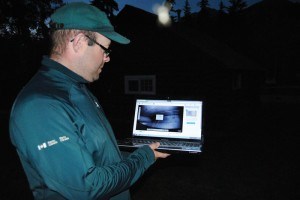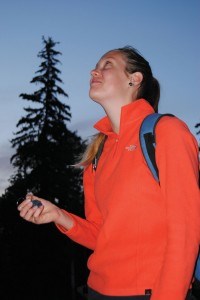
Routinely feared and often despised, bats are among some of the most misunderstood mammals in Jasper National Park.
In recent weeks, Parks Canada has begun monitoring and counting bats in two different locations in the park to get a better understanding of the nocturnal creatures.
In JNP there are several different species of bats. The most common are the Northern Myotes and the Little Brown Bat. Both species were designated as endangered by the Committee on the Status of Endangered Wildlife in Canada (COSEWIC) during an emergency meeting in 2012.
“In the mountain national parks we don’t really know a lot about our bat populations,” said Kevin Gedling, a partnering engagement officer for Parks Canada who offered to run the monitoring program.
“We’re trying to get more information about how many bats we have, what they’re up to and where they like to live.”
North America has seen a rapid decline in bat populations because of White-nose Syndrome (WNS).
Named after the white fungus that appears on the muzzle of bats, the fungal disease was first detected in Canada in 2010, and to date has caused a 94 per cent overall decline in known numbers of both bat species in Nova Scotia, New Brunswick, Ontario, and Quebec, according to COSEWIC.
The current range of WNS has been expanding at an average rate of 200 to 250 km per year. At that rate, the entire Canadian bat population is likely to be affected within 12 to 18 years, the committee stated.
Evidence suggests WNS may be caused by an invasive fungus possibly from Europe and spread unintentionally by humans, although bat-to-bat transmission is believed to be the primary vector for the spread of the fungus.
Bats with WNS act strangely during cold winter months, including flying outside in the day and clustering near the entrances of caves and mines where they hibernate.
To date, there have been no documented cases of WNS among bat populations in Alberta.
“We know lots about our bears, we know lots about our big ecosystems, but bats are a really misunderstood animal and I hate to say it, they kind of slipped through the cracks in years past,” said Gedling.

To count the bats, Parks’ staff and volunteers patiently wait outside buildings that are known to house bats and record the number that leave their roost over the course of an hour, using a clicker. The best time to do this is at dusk.
Although not an exact science, Parks intends to visit two locations—the Palisades Stewardship Education Centre and Pocahontas—four times over the summer to get a better sample size.
“I would definitely recommend it,” said Nirmolak Kang, about counting bats.
“When I heard more about the White-nose Syndrome and how it actually affects the hibernating bats I thought it was really sad that something we do affects these little guys so much,” she said while volunteering.
During an outing last week, Parks staff and employees recorded 23 bats over the course of an hour, far fewer than the previous week’s total which included more than 100 bats.
“That’s why you need to do several counts over a period of time, because one count can be influenced by a number of things,” said Gedling, explaining weather and the time of year can play a factor.
In additional to counting the bats visually, Parks installed three cameras at the Palisades Centre to record the bats as they roost inside one of the buildings.
“There’s a lot of scary misinformation about bats, that they carry diseases and that they’re dangerous, but they’re really not,” said Gedling, “They’re more beneficial than anything.
“As we learn more about them, that gives us more information that we can in turn give to people.” he said.
To volunteer to count bats, email Parks Canada at [email protected] or call the office at 780-852-6176.
Paul Clarke [email protected]
